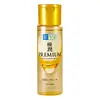What's inside
What's inside
 Key Ingredients
Key Ingredients

 Benefits
Benefits

 Concerns
Concerns

No concerns
 Ingredients Side-by-side
Ingredients Side-by-side

Water
Skin ConditioningButylene Glycol
HumectantHydroxyethyl Urea
HumectantPPG-10 Methyl Glucose Ether
Skin ConditioningDiglycerin
HumectantSodium Hyaluronate
HumectantHydrolyzed Hyaluronic Acid
HumectantSodium Acetylated Hyaluronate
HumectantHydroxypropyltrimonium Hyaluronate
Sodium Hyaluronate Crosspolymer
HumectantLactobacillus/Sodium Hyaluronate Ferment Filtrate
EmollientHydrolyzed Sodium Hyaluronate
Skin ConditioningSaccharide Hydrolysate
HumectantHydrogenated Starch Hydrolysate
HumectantGlycosyl Trehalose
Emulsion StabilisingSorbitol
HumectantTriethyl Citrate
MaskingPEG-32
HumectantCarbomer
Emulsion StabilisingPEG-75
HumectantDisodium Succinate
MaskingPropanediol
SolventDiethoxyethyl Succinate
SolventPotassium Hydroxide
BufferingSuccinic Acid
BufferingDisodium EDTA
Polyquaternium-51
Skin ConditioningCaprylhydroxamic Acid
Hydroxyethylcellulose
Emulsion StabilisingXanthan Gum
EmulsifyingPhenoxyethanol
PreservativeWater, Butylene Glycol, Hydroxyethyl Urea, PPG-10 Methyl Glucose Ether, Diglycerin, Sodium Hyaluronate, Hydrolyzed Hyaluronic Acid, Sodium Acetylated Hyaluronate, Hydroxypropyltrimonium Hyaluronate, Sodium Hyaluronate Crosspolymer, Lactobacillus/Sodium Hyaluronate Ferment Filtrate, Hydrolyzed Sodium Hyaluronate, Saccharide Hydrolysate, Hydrogenated Starch Hydrolysate, Glycosyl Trehalose, Sorbitol, Triethyl Citrate, PEG-32, Carbomer, PEG-75, Disodium Succinate, Propanediol, Diethoxyethyl Succinate, Potassium Hydroxide, Succinic Acid, Disodium EDTA, Polyquaternium-51, Caprylhydroxamic Acid, Hydroxyethylcellulose, Xanthan Gum, Phenoxyethanol
Water
Skin ConditioningDipropylene Glycol
HumectantGlycerin
HumectantDiglycerin
HumectantPEG-6
HumectantButylene Glycol
HumectantBetaine
HumectantPEG/PPG-17/4 Dimethyl Ether
Skin ConditioningPEG-60 Hydrogenated Castor Oil
EmulsifyingPhenoxyethanol
PreservativePolyglyceryl-2 Diisostearate
EmulsifyingIsodecyl Neopentanoate
EmollientMethylparaben
PreservativeDisodium EDTA
Sodium Citrate
BufferingParfum
MaskingAlcohol
AntimicrobialErythritol
HumectantPEG/PPG-14/7 Dimethyl Ether
Skin ConditioningTremella Fuciformis Polysaccharide
Emulsion StabilisingPotassium Cocoyl Glutamate
Citric Acid
BufferingLinalool
PerfumingSapindus Mukorossi Peel Extract
Skin ConditioningSodium Metabisulfite
AntioxidantCitronellol
PerfumingGeraniol
PerfumingMagnesium Chloride
Oenothera Biennis Oil
EmollientCalcium Chloride
AstringentSerine
MaskingHamamelis Virginiana Leaf Extract
Skin ConditioningTocopherol
AntioxidantZingiber Aromaticus Extract
Skin ConditioningSodium Acetylated Hyaluronate
HumectantCitrus Junos Seed Extract
AntioxidantWater, Dipropylene Glycol, Glycerin, Diglycerin, PEG-6, Butylene Glycol, Betaine, PEG/PPG-17/4 Dimethyl Ether, PEG-60 Hydrogenated Castor Oil, Phenoxyethanol, Polyglyceryl-2 Diisostearate, Isodecyl Neopentanoate, Methylparaben, Disodium EDTA, Sodium Citrate, Parfum, Alcohol, Erythritol, PEG/PPG-14/7 Dimethyl Ether, Tremella Fuciformis Polysaccharide, Potassium Cocoyl Glutamate, Citric Acid, Linalool, Sapindus Mukorossi Peel Extract, Sodium Metabisulfite, Citronellol, Geraniol, Magnesium Chloride, Oenothera Biennis Oil, Calcium Chloride, Serine, Hamamelis Virginiana Leaf Extract, Tocopherol, Zingiber Aromaticus Extract, Sodium Acetylated Hyaluronate, Citrus Junos Seed Extract
 Reviews
Reviews

Alternatives
Ingredients Explained
These ingredients are found in both products.
Ingredients higher up in an ingredient list are typically present in a larger amount.
Butylene Glycol (or BG) is used within cosmetic products for a few different reasons:
Overall, Butylene Glycol is a safe and well-rounded ingredient that works well with other ingredients.
Though this ingredient works well with most skin types, some people with sensitive skin may experience a reaction such as allergic rashes, closed comedones, or itchiness.
Learn more about Butylene GlycolDiglycerin is a humectant. It is derived from glycerin, which is naturally found in your skin.
As a humectant, it helps draw moisture to the skin from the air.
Disodium EDTA plays a role in making products more stable by aiding other preservatives.
It is a chelating agent, meaning it neutralizes metal ions that may be found in a product.
Disodium EDTA is a salt of edetic acid and is found to be safe in cosmetic ingredients.
Learn more about Disodium EDTAPhenoxyethanol is a preservative that has germicide, antimicrobial, and aromatic properties. Studies show that phenoxyethanol can prevent microbial growth. By itself, it has a scent that is similar to that of a rose.
It's often used in formulations along with Caprylyl Glycol to preserve the shelf life of products.
Sodium Acetylated Hyaluronate is a type of Hyaluronic Acid.
Hyaluronic Acids help moisturize, soothe, and protect the skin.
Read about common types of Hyaluronic Acid here:
Sodium Hyaluronate
Hydrolyzed Hyaluronic Acid
Hyaluronic Acid
Water. It's the most common cosmetic ingredient of all. You'll usually see it at the top of ingredient lists, meaning that it makes up the largest part of the product.
So why is it so popular? Water most often acts as a solvent - this means that it helps dissolve other ingredients into the formulation.
You'll also recognize water as that liquid we all need to stay alive. If you see this, drink a glass of water. Stay hydrated!
Learn more about Water